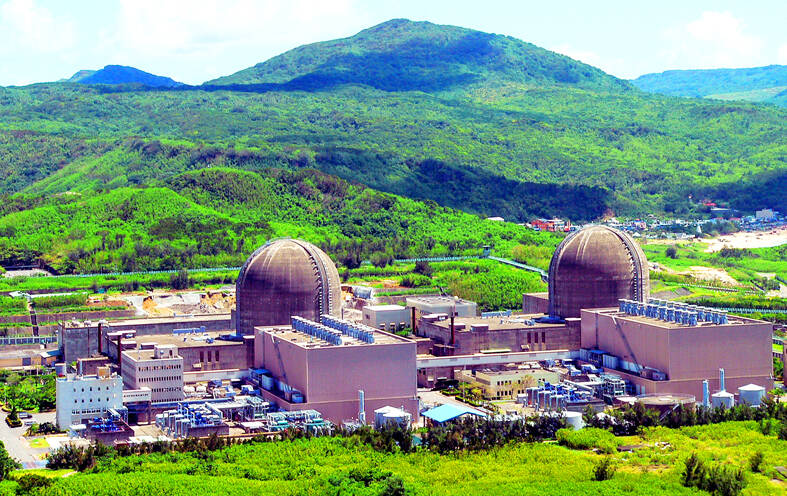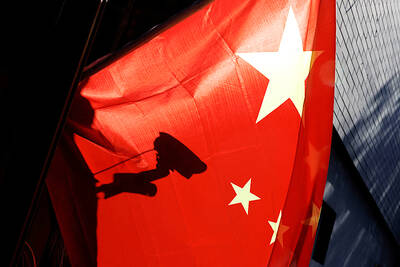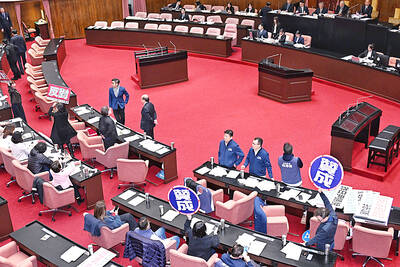Taiwan yesterday shut down the No. 1 reactor of its only active nuclear plant, poised to become the first non-nuclear country in East Asia after the last reactor’s license expires in May next year.
The closure of the No. 1 reactor at the Ma-anshan Nuclear Power Plant in Pingtung County’s Ma-anshan (馬鞍山) comes amid a continuing debate among lawmakers about whether to extend the service life of the nation’s existing atomic energy facilities.
Before the closing of the No. 1 reactor, nuclear power accounted for about 5 percent of the nation’s energy use, which is dominated by coal and liquefied natural gas (LNG).

Photo courtesy of the Taiwan Power Co
The state-run Taiwan Power Co (Taipower, 台電) yesterday said that with the closure of the No. 1 reactor, the total percentage of power generated by nuclear sources would fall to 2.8 percent.
To assuage public concern regarding power stability, the Ministry of Economic Affairs said it has negotiated with Sun Ba Power Corp (森霸電力) to use the power generated from its No. 3 LNG unit to buttress the power generation shortfall.
The unit can generate 1,100 megawatts, which is greater than the 951 megawatts put out by the Ma-anshan Nuclear Power Plant’s No. 1 reactor, the ministry said.
However, phasing out nuclear power generation and replacing it with LNG would bring other challenges regarding power prices and carbon emissions, industry observers said.
Energy security is a critical issue in Taiwan and its chipmaking industry, led by Taiwan Semiconductor Manufacturing Co (台積電).
The issue has taken on added importance as Beijing exerts more pressure on Taipei.
The tensions are stoking concerns that China could potentially limit Taiwan’s energy supplies through a military blockade.
The 2011 meltdown at the Fukushima Dai-ichi nuclear power plant in Japan helped turn popular opinion in Taiwan against the industry.
The government said it would not rule out boosting nuclear power’s share of the energy mix, but said the technology needs to improve.
The last reactor at the Ma-anshan Nuclear Power Plant is set to close in May next year. Both it and the No. 1 reactor’s closing are planned retirements after about 40 years of use.
The moves buck a global trend of renewed interest in nuclear energy, which produces no greenhouse gas emissions, but results in toxic waste that can remain radioactive for millennia.
Lawmakers this month debated for hours over whether to reverse course on the government’s plan to completely phase out nuclear power, although no vote was taken.
The use of nuclear energy has long been a source of contention between the ruling and opposition parties.
When the Democratic Progressive Party took office in 2016, then-president Tsai Ing-wen (蔡英文) said her goal was to make Taiwan nuclear-free by next year, setting a target energy mix of 50 percent natural gas, 30 percent coal and 20 percent renewables.
Opposition parties have advocated restarting nuclear reactors.
Taiwan now expects renewable energy to comprise one-quarter of its energy mix by 2030, up from about 12 percent this year.
Power consumption is forecast to grow by an average of 2.8 percent a year through 2033, driven by the artificial intelligence sector.
While Taiwan has a surplus of electricity, according to Premier Cho Jung-tai (卓榮泰), that growth could crimp the excess supply in the years ahead.
Additional reporting by Lin Chin-hua

A magnitude 7.0 earthquake struck off Yilan at 11:05pm yesterday, the Central Weather Administration (CWA) said. The epicenter was located at sea, about 32.3km east of Yilan County Hall, at a depth of 72.8km, CWA data showed There were no immediate reports of damage. The intensity of the quake, which gauges the actual effect of a seismic event, measured 4 in Yilan County area on Taiwan’s seven-tier intensity scale, the data showed. It measured 4 in other parts of eastern, northern and central Taiwan as well as Tainan, and 3 in Kaohsiung and Pingtung County, and 2 in Lienchiang and Penghu counties and 1

FOREIGN INTERFERENCE: Beijing would likely intensify public opinion warfare in next year’s local elections to prevent Lai from getting re-elected, the ‘Yomiuri Shimbun’ said Internal documents from a Chinese artificial intelligence (AI) company indicated that China has been using the technology to intervene in foreign elections, including propaganda targeting Taiwan’s local elections next year and presidential elections in 2028, a Japanese newspaper reported yesterday. The Institute of National Security of Vanderbilt University obtained nearly 400 pages of documents from GoLaxy, a company with ties to the Chinese government, and found evidence that it had apparently deployed sophisticated, AI-driven propaganda campaigns in Hong Kong and Taiwan to shape public opinion, the Yomiuri Shimbun reported. GoLaxy provides insights, situation analysis and public opinion-shaping technology by conducting network surveillance

‘POLITICAL GAME’: DPP lawmakers said the motion would not meet the legislative threshold needed, and accused the KMT and the TPP of trivializing the Constitution The Legislative Yuan yesterday approved a motion to initiate impeachment proceedings against President William Lai (賴清德), saying he had undermined Taiwan’s constitutional order and democracy. The motion was approved 61-50 by lawmakers from the main opposition Chinese Nationalist Party (KMT) and the smaller Taiwan People’s Party (TPP), who together hold a legislative majority. Under the motion, a roll call vote for impeachment would be held on May 19 next year, after various hearings are held and Lai is given the chance to defend himself. The move came after Lai on Monday last week did not promulgate an amendment passed by the legislature that

AFTERMATH: The Taipei City Government said it received 39 minor incident reports including gas leaks, water leaks and outages, and a damaged traffic signal A magnitude 7.0 earthquake struck off Taiwan’s northeastern coast late on Saturday, producing only two major aftershocks as of yesterday noon, the Central Weather Administration (CWA) said. The limited aftershocks contrast with last year’s major earthquake in Hualien County, as Saturday’s earthquake occurred at a greater depth in a subduction zone. Saturday’s earthquake struck at 11:05pm, with its hypocenter about 32.3km east of Yilan County Hall, at a depth of 72.8km. Shaking was felt in 17 administrative regions north of Tainan and in eastern Taiwan, reaching intensity level 4 on Taiwan’s seven-tier seismic scale, the CWA said. In Hualien, the